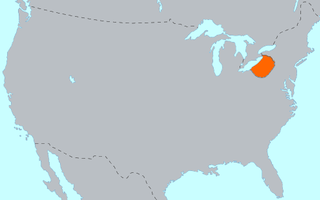
The Tuscarora are an Indigenous People of the Northeastern Woodlands in Canada and the United States. They are an Iroquoian Native American and First Nations people. The Tuscarora Nation, a federally recognized tribe, is based in New York, and the Tuscarora First Nation is one of the Six Nations of the Grand River in Ontario.

The Quinnipiac were a historical Indigenous people of the Northeastern Woodlands. They lived in present-day New Haven County, Connecticut, along the Quinnipiac River. Their primary village, also called Quinnipiac, was where New Haven, Connecticut is today.

The Tuscarora War was fought in North Carolina from September 10, 1711, until February 11, 1715, between the Tuscarora people and their allies on one side and European American settlers, the Yamasee, and other allies on the other. This was considered the bloodiest colonial war in North Carolina. The Tuscarora signed a treaty with colonial officials in 1718 and settled on a reserved tract of land in Bertie County, North Carolina. The war incited further conflict on the part of the Tuscarora and led to changes in the slave trade of North and South Carolina.

The Pamlico were Native Americans of North Carolina. They spoke an Algonquian language also known as Pamlico or Carolina Algonquian.

The Erie people were an Indigenous people of the Northeastern Woodlands historically living on the south shore of Lake Erie. An Iroquoian-speaking tribe, they lived in what is now western New York, northwestern Pennsylvania, and northern Ohio before 1658. Their nation was almost exterminated in the mid-17th century by five years of prolonged warfare with the powerful neighboring Iroquois for helping the Huron in the Beaver Wars for control of the fur trade. Captured survivors were adopted or enslaved by the Iroquois.

The Meherrin people are an Indigenous people of the Northeastern Woodlands, who spoke an Iroquian language. They lived between the Piedmont and coastal plains at the border of Virginia and North Carolina.

The Manahoac, also recorded as Mahock, were a Indigenous people of the Northeastern Woodlands, who lived in northern Virginia at the time of European contact. They spoke a Siouan language and numbered approximately 1,000.
The Machapunga were a small Algonquian language–speaking Native American tribe from coastal northeastern North Carolina. They were part of the Secotan people. They were a group from the Powhatan Confederacy who migrated from present-day Virginia.

The Piscataway Indian Nation, also called Piscataway Indian Nation Inc. is a state-recognized tribe in Maryland who identify as descendants of the historic Piscataway people. At the time of European encounter, the Piscataway was one of the most populous and powerful Native polities of the Chesapeake Bay region, with a territory on the north side of the Potomac River. By the early seventeenth century, the Piscataway had come to exercise hegemony over other Algonquian-speaking Native American groups on the north bank of the river. The Piscataway nation declined dramatically before the nineteenth century, under the influence of colonization, infectious disease, and intertribal and colonial warfare.

The Occaneechi are Indigenous peoples of the Northeastern Woodlands whose historical territory was in the Piedmont region of present-day North Carolina and Virginia.

The Chesepian or Chesapeake were a Native American tribe who lived near present-day South Hampton Roads in the U.S. state of Virginia. They occupied an area which is now the Norfolk County or Princess Anne County.

The Cusabo were a group of American Indian tribes who lived along the coast of the Atlantic Ocean in what is now South Carolina, approximately between present-day Charleston and south to the Savannah River, at the time of European colonization. English colonists often referred to them as one of the Settlement Indians of South Carolina, tribes who "settled" among the colonists.

The Nottoway are an Iroquoian Native American tribe in Virginia. The Nottoway spoke a Nottoway language in the Iroquoian language family.

The Chowanoc, also Chowanoke, were an Algonquian-speaking Native American tribe who historically lived near the Chowan River in North Carolina.
The Yatasi were Native American peoples from northwestern Louisiana that were part of the Natchitoches Confederacy of the Caddo Nation. Today they are enrolled in the Caddo Nation of Oklahoma.
The Appomattoc were a historic tribe of Virginia Indians speaking an Algonquian language, and residing along the lower Appomattox River, in the area of what is now Petersburg, Colonial Heights, Chesterfield and Dinwiddie Counties in present-day southeast Virginia.

The Agawam were an Algonquian Native American people inhabiting the coast of New England encountered by English colonists who arrived in the early 17th century. Decimated by pestilence shortly before the English colonization and fearing attacks from their hereditary enemies among the Abenaki and other tribes of present-day Maine, they invited the English to settle with them on their tribal territory.

The Secotans were one of several groups of Native Americans dominant in the Carolina sound region, between 1584 and 1590, with which English colonists had varying degrees of contact. Secotan villages included the Secotan, Aquascogoc, Dasamongueponke, Pomeiock (Pamlico) and Roanoac. Other local groups included the Chowanoke, Weapemeoc, Chesapeake, Ponouike, Neusiok, and Mangoak (Tuscarora), and all resided along the banks of the Albemarle and Pamlico sounds.

The Neusiok were an Indigenous people of the Southeastern Woodlands in present-day North Carolina. They were also known as the Neuse Indians.
The Hatteras Indians were a tribe of Native Americans in the United States who lived in the North Carolina Outer Banks. They inhabited a village on what is now called Hatteras Island called Croatoan.














